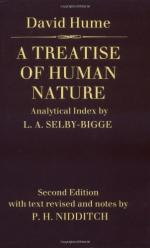The idea of solidity is that of two objects, which being impelled by the utmost force, cannot penetrate each other; but still maintain a separate and distinct existence. Solidity, therefore, is perfectly incomprehensible alone, and without the conception of some bodies, which are solid, and maintain this separate and distinct existence. Now what idea have we of these bodies? The ideas of colours, sounds, and other secondary qualities are excluded. The idea of motion depends on that of extension, and the idea of extension on that of solidity. It is impossible, therefore, that the idea of solidity can depend on either of them. For that would be to run in a circle, and make one idea depend on another, while at the same time the latter depends on the former. Our modern philosophy, therefore, leaves us no just nor satisfactory idea of solidity; nor consequently of matter.
This argument will appear entirely conclusive to every one that comprehends it; but because it may seem abstruse and intricate to the generality of readers, I hope to be excused, if I endeavour to render it more obvious by some variation of the expression. In order to form an idea of solidity, we must conceive two bodies pressing on each other without any penetration; and it is impossible to arrive at this idea, when we confine ourselves to one object, much more without conceiving any. Two non-entities cannot exclude each other from their places; because they -never possess any place, nor can be endowed with any quality. Now I ask, what idea do we form of these bodies or objects, to which we suppose solidity to belong? To say, that we conceive them merely as solid, is to run on in infinitum. To affirm, that we paint them out to ourselves as extended, either resolves all into a false idea, or returns in a circle. Extension must necessarily be considered either as coloured, which is a false idea; I or as solid, which brings us back to the first question. We may make the same observation concerning mobility and figure; and upon the whole must conclude, that after the exclusion of colours, sounds, heat and cold from the rank of external existences, there remains nothing, which can afford us a just and constituent idea of body.
Add to this, that, properly speaking, solidity or impenetrability is nothing, but an impossibility of annihilation, as [Part II. Sect. 4.] has been already observed: For which reason it is the more necessary for us to form some distinct idea of that object, whose annihilation we suppose impossible. An impossibility of being annihilated cannot exist, and can never be conceived to exist, by itself: but necessarily requires some object or real existence, to which it may belong. Now the difficulty still remains, how to form an idea of this object or existence, without having recourse to the secondary and sensible qualities.




